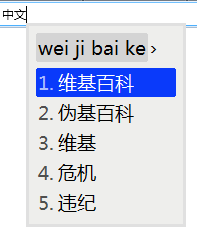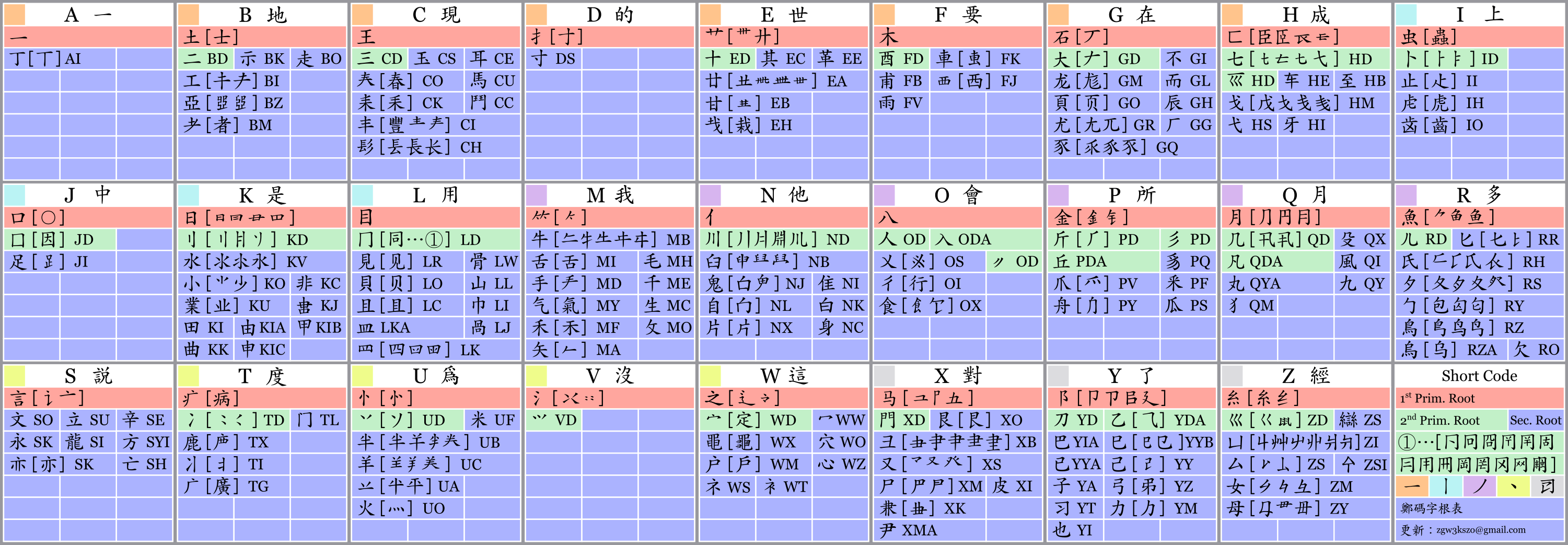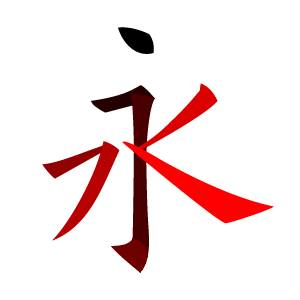|
Biaoxingma Method
The Biaoxingma Input Method (), also abbreviated to simply Biaoxingma (), is a kind of shape-based Chinese character input method invented by Chen Aiwen, an overseas Chinese scholar living in France in the 1980s. Because it is intuitive in the splitting of Chinese characters and has theoretical support in Chinese characters, it had once attracted widespread attention at the beginning of the invention and was listed as a key project in China Torch Project. However, there was afterwards no such influence as Wubi method and Zhengma method in terms of popularization and commercialization. Biaoxingma was pre-installed by Microsoft in Chinese Windows 95 and Windows 98 first edition, but was removed from Windows 98 second edition and later Windows versions. Biaoxingma was also installed in IBM AIX. Basics The smallest constituent parts of each Chinese character are called strokes. One or more strokes form the components of a character. Characters are divided into several componen ... [...More Info...] [...Related Items...] OR: [Wikipedia] [Google] [Baidu] |
Chinese Input Methods For Computers
Chinese input methods are methods that allow a computer user to input Chinese characters. Most, if not all, Chinese input methods fall into one of two categories: phonetic readings or root shapes. Methods under the phonetic category usually are easier to learn but are less efficient, thus resulting in slower typing speeds because they typically require users to choose from a list of phonetically similar characters for input, whereas methods under the root shape category allow very precise and speedy input but have a steep learning curve because they often require a thorough understanding of a character's strokes and composition. Other methods allow users to write characters directly onto touchscreens, such as those found on mobile phones and tablet computers. History Chinese input methods predate the computer. One of the early attempts was an electro-mechanical Chinese typewriter Ming kwai () which was invented by Lin Yutang, a prominent Chinese writer, in the 1940s. It assigne ... [...More Info...] [...Related Items...] OR: [Wikipedia] [Google] [Baidu] |
Chen Aiwen
Chen may refer to: People *Chen (surname) (陳 / 陈), a common Chinese surname * Chen (singer) (born 1992), member of the South Korean-Chinese boy band EXO * Chen Chen (born 1989), Chinese-American poet * (), a Hebrew first name or surname: **Hen Lippin (born 1965), former Israeli basketball player **Chen Reiss (born 1979), Israeli operatic soprano **Ronen Chen (born 1965), Israeli fashion designer Historical states * Chen (state) (c. 1045 BC–479 BC), a Zhou dynasty state in present-day Anhui and Henan *Chen (Thessaly), a city-state in ancient Thessaly, Greece *Chen Commandery, a commandery in China from Han dynasty to Sui dynasty * Chen dynasty (557–589), a Chinese southern dynasty during the Northern and Southern dynasties period Businesses and organizations * Council for Higher Education in Newark (CHEN) * Chen ( he, ח״ן), acronym in Hebrew for the Women's Army Corps (, ) a defunct organization in the Israeli Defence Force * Chen, a brand name used by Mexican ... [...More Info...] [...Related Items...] OR: [Wikipedia] [Google] [Baidu] |
China Torch Project
China, officially the People's Republic of China (PRC), is a country in East Asia. It is the world's most populous country, with a population exceeding 1.4 billion, slightly ahead of India. China spans the equivalent of five time zones and borders fourteen countries by land, the most of any country in the world, tied with Russia. Covering an area of approximately , it is the world's third largest country by total land area. The country consists of 22 provinces, five autonomous regions, four municipalities, and two Special Administrative Regions (Hong Kong and Macau). The national capital is Beijing, and the most populous city and financial center is Shanghai. Modern Chinese trace their origins to a cradle of civilization in the fertile basin of the Yellow River in the North China Plain. The semi-legendary Xia dynasty in the 21st century BCE and the well-attested Shang and Zhou dynasties developed a bureaucratic political system to serve hereditary monarchies, or dyna ... [...More Info...] [...Related Items...] OR: [Wikipedia] [Google] [Baidu] |
Wubi Method
The Wubizixing input method (), often abbreviated to simply Wubi or Wubi Xing,This is the name used in Mac OS X is a Chinese character input method primarily for inputting simplified Chinese and traditional Chinese text on a computer. Wubi should not be confused with the Wubihua (五笔画) method, which is a different input method that shares the categorization into five types of strokes. The method is also known as Wang Ma (), named after the inventor Wang Yongmin (王永民). There are four Wubi versions that are considered to be standard: Wubi 86, Wubi 98, Wubi 18030 and Wubi New-century (the 3rd-generation Version). The latter three can also be used to input traditional Chinese text, albeit in a more limited way. Wubi 86 is the most widely known and used shape-based input method for full letter keyboards in Mainland China. If it is frequently needed to input traditional Chinese characters as well, other input methods like Cangjie or Zhengma may be better suited to th ... [...More Info...] [...Related Items...] OR: [Wikipedia] [Google] [Baidu] |
Zhengma Method
The Zhengma Input Method (Simplified Chinese: 郑码输入法, Traditional Chinese: 鄭碼輸入法) (also referred to as Zheng code method) is a Chinese input methods for computers, Chinese language input method. The primary goal of Zhengma design is compatibility with different types of characters (ability to input both simplified Chinese and traditional Chinese), scalability (it works well with extremely large sets of ideographs) and ease of use, especially for people who are experienced with how ideographs are formed. For these reasons this input method is used more by scholars of the Chinese language or people who need to use both traditional and simplified Chinese. This input method is one of two stroke-based input method that are included with Windows operating system, Microsoft Windows. (The other stroke-based method is Cangjie input method, Cangjie which can also generate both simplified and traditional characters and which is extensively taught and used in Taiwan and Hong ... [...More Info...] [...Related Items...] OR: [Wikipedia] [Google] [Baidu] |
Microsoft
Microsoft Corporation is an American multinational technology corporation producing computer software, consumer electronics, personal computers, and related services headquartered at the Microsoft Redmond campus located in Redmond, Washington, United States. Its best-known software products are the Windows line of operating systems, the Microsoft Office suite, and the Internet Explorer and Edge web browsers. Its flagship hardware products are the Xbox video game consoles and the Microsoft Surface lineup of touchscreen personal computers. Microsoft ranked No. 21 in the 2020 Fortune 500 rankings of the largest United States corporations by total revenue; it was the world's largest software maker by revenue as of 2019. It is one of the Big Five American information technology companies, alongside Alphabet, Amazon, Apple, and Meta. Microsoft was founded by Bill Gates and Paul Allen on April 4, 1975, to develop and sell BASIC interpreters for the Altair 8800. It rose to do ... [...More Info...] [...Related Items...] OR: [Wikipedia] [Google] [Baidu] |
Windows 95
Windows 95 is a consumer-oriented operating system developed by Microsoft as part of its Windows 9x family of operating systems. The first operating system in the 9x family, it is the successor to Windows 3.1x, and was released to manufacturing on July 14, 1995, and generally to retail on August 24, 1995, almost three months after the release of Windows NT 3.51. Windows 95 merged Microsoft's formerly separate MS-DOS and Microsoft Windows products, and featured significant improvements over its predecessor, most notably in the graphical user interface (GUI) and in its simplified "plug-and-play" features. There were also major changes made to the core components of the operating system, such as moving from a mainly cooperatively multitasked 16-bit architecture to a 32-bit preemptive multitasking architecture, at least when running only 32-bit protected mode applications. Accompanied by an extensive marketing campaign, Windows 95 introduced numerous functions and features that w ... [...More Info...] [...Related Items...] OR: [Wikipedia] [Google] [Baidu] |
Windows 98
Windows 98 is a consumer-oriented operating system developed by Microsoft as part of its Windows 9x family of Microsoft Windows operating systems. The second operating system in the 9x line, it is the successor to Windows 95, and was released to manufacturing on May 15, 1998, and generally to retail on June 25, 1998. Like its predecessor, it is a hybrid 16-bit and 32-bit monolithic product with the boot stage based on MS-DOS. Windows 98 is a web-integrated operating system that bears numerous similarities to its predecessor. Most of its improvements were cosmetic or designed to improve the user experience, but there were also a handful of features introduced to enhance system functionality and capabilities, including improved USB support and accessibility, as well as support for hardware advancements such as DVD players. Windows 98 was the first edition of Windows to adopt the Windows Driver Model, and introduced features that would become standard in future generations of Wind ... [...More Info...] [...Related Items...] OR: [Wikipedia] [Google] [Baidu] |
IBM AIX
AIX (Advanced Interactive eXecutive, pronounced , "ay-eye-ex") is a series of Proprietary software, proprietary Unix operating systems developed and sold by IBM for several of its computer platforms. Background Originally released for the IBM RT PC RISC workstation in 1986, AIX has supported a wide variety of hardware platforms, including the IBM RS/6000 series and later IBM Power microprocessors, Power and PowerPC-based systems, IBM System i, System/370 mainframes, IBM Personal System/2, PS/2 personal computers, and the Apple Network Server. It is currently supported on IBM Power Systems alongside IBM i and Linux. AIX is based on UNIX System V with 4.3BSD-compatible extensions. It is certified to the UNIX 03 and UNIX V7 marks of the Single UNIX Specification, beginning with AIX versions 5.3 and 7.2 TL5 respectively. Older versions were previously certified to the UNIX 95 and UNIX 98 marks. AIX was the first operating system to have a journaling file system, and IBM has c ... [...More Info...] [...Related Items...] OR: [Wikipedia] [Google] [Baidu] |
Stroke (CJK Character)
CJK strokes () are the calligraphic strokes needed to write the Chinese characters in regular script used in East Asian calligraphy. CJK strokes are the classified set of line patterns that may be arranged and combined to form Chinese characters (also known as Hanzi) in use in China, Japan, and Korea. Purpose The study and classification of CJK strokes is used for: #understanding Chinese character calligraphy – the correct method of writing, shape formation and stroke order required for character legibility; #understanding stroke changes according to the style that is in use; #defining stroke naming and counting conventions; #identifying fundamental components of Han radicals; and #their use in computing. Formation When writing Han radicals, a single stroke includes all the motions necessary to produce a given part of a character before lifting the writing instrument from the writing surface; thus, a single stroke may have abrupt changes in direction within the line. ... [...More Info...] [...Related Items...] OR: [Wikipedia] [Google] [Baidu] |
Han Character Input
Han may refer to: Ethnic groups * Han Chinese, or Han People (): the name for the largest ethnic group in China, which also constitutes the world's largest ethnic group. ** Han Taiwanese (): the name for the ethnic group of the Taiwanese people who may be fully or partially Han Chinese descent. * Han Minjok, or Han people (): the Korean native name referring to Koreans. * Hän: one of the First Nations peoples of Canada. Former states * Han (Western Zhou state) (韓) (11th century BC – 757 BC), a Chinese state during the Spring and Autumn period * Han (state) (韓) (403–230 BC), a Chinese state during the Warring States period * Han dynasty (漢/汉) (206 BC – 220 AD), a dynasty split into two eras, Western Han and Eastern Han ** Shu Han (蜀漢) (221–263), a Han Chinese dynasty that existed during the Three Kingdoms Period * Former Zhao (304–329), one of the Sixteen Kingdoms, known as Han (漢) before 319 * Cheng Han (成漢) (304–347), one of the Sixte ... [...More Info...] [...Related Items...] OR: [Wikipedia] [Google] [Baidu] |




